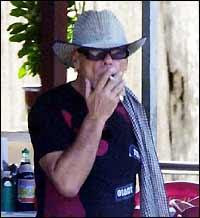What is goinng on with dinosaurs?

This is just getting spooky. Why so many in such a relatively short time?
Sure the last one shown is from 2004, but that's a mere drop in the ocean of time.
New dinosaur species unveiled in Rio de Janeiro
New Dinosaur Species Found in India
New Dinosaur Species Discovered in Argentina
NEW DINOSAUR SPECIES IN BRAZIL
Two new dinosaur species found in Antarctica - Feb. 26, 2004
I'm no paleontologist, but do discoveries of new species come in groups? Are paleontologists getting better at distinguishing species? Are there more paleontologists running around?
I was saving that picture for cat blogging. Follow the link. Its much kewler over there. Not working here for me.
Labels: dinosaurs














2 Comments:
A dinosaur mystery that puzzled paleontologists for nearly a century has been solved by a pound of beef tendons from a butcher, a collection of dead hawks and a brace of frozen quail, two investigative scientists in Berkeley and Idaho say.
The puzzle: Why were fossils of those ancient creatures so often discovered buried with their heads, necks and feet arched bizarrely backward into a distorted posture unlike anything seen alive?
The answer: Kevin Padian, a noted dinosaur expert and curator of the Museum of Paleontology at UC Berkeley, and Cynthia Marshall Faux, a veterinarian and paleontologist at the Museum of the Rockies in Bozeman, Mont., say the beasts were suffering in violent death throes as they perished -- asphyxiated by volcanic gases or ash falls, poisoned by unknown toxins or drowned in swamps or deepwater lakes.
It was knowledge of animals in veterinary clinics plus a few "kitchen science" experiments that led to this conclusion, say the researchers, and it should provide a new understanding of the dinosaurs' environments millions of years ago. It also adds support for the once-controversial claim that the ancient dinosaurs were all warm-blooded just as modern birds are, and unlike the ancestral crocodiles and lizards whose blood still runs cold today.
When paleontologists years ago were struck by the peculiar posture of most fossil dinosaur skeletons, they offered many explanations in their reports: The skeletons always developed that way after death, they said -- strong currents must have bent the bodies that way before sediments could bury them; or their necks were broken backward as a result of diving or falling into mud; or salts in evaporated water stiffened them into position after death; or dry air shriveled the tendons in their dead bodies until the skeletons bent; or it was all an example of rigor mortis -- the stiffening of any body that follows quickly after death.
It was Faux (pronounced Fox) who devised the experiments that solved the problem, Padian said. She is a vet turned paleontologist who also affiliated with Yale University's famed Peabody Museum of Natural History.
Based on her experience in animal clinics, she reasoned that the deformed posture of the dinosaurs seemed clearly due to damage to their central nervous systems before death, and she set about to test whether the idea held up for dinosaurs as well as modern animals.
Faux is a large-animal specialist who lives near Lewiston, Idaho, and at a nearby butcher's shop she bought a few pounds of beef tendons, dried some, salted some, soaked some, and showed that none shrank in any way that could possibly have distorted an animal skeleton.
For two months she dried the bodies of two red-tailed hawks euthanized at the Raptor Conservation Center in Bozeman and found no post-mortem movement at all. She immobilized the bodies of badly injured barn owls and falcons from the raptor center, and their muscles and tendons didn't move.
Finally, she bought two frozen quail from a commercial quail farm, thawed them, soaked them in a heavy salt solution, and observed their decomposing bodies for as long as two weeks. Their bones never took on that bizarre distorted posture like the fossil dinosaurs -- known in medicine as opisthotonus.
Opisthotonus during death occurs only in warm-blooded animals like birds and mammals today, but not in cold-blooded creatures, Padian said -- so this work offers new support for the idea that dinosaurs must have been warm-blooded too, he said.
Faux's detailed experimentation was truly persistent research, Padian said. It was, he said, "powerful kitchen science."
"The prevalent idea has been that these animals distorted posture occurred only after death with no scavenging of their bones, and then were somehow buried by currents of water and mud," Padian said. "Our study suggests that many of these animals died instead in places that were already inundated, and that they maintained their death postures as they were quickly buried."
And because many paleontologists have based inferences about dinosaur environments on the state of their skeletons in the rock layers where they are found, Padian said, some traditional views of "paleoenvironments" will now need some new thinking.
The work by Faux and Padian was published in the current issue of the journal Paleobiology.
E-mail David Perlman at dperlman@sfchronicle.com.
This article appeared on page A - 7 of the San Francisco Chronicle
Fausto Intilla
www.oloscience.com
Thank you. Great info.
I'm a politics junkie, but try not to limit myself.
I love the "kitchen science". Isn't that how many of us did it as children?
Experiments are experiments regardless of the surroundings unless extreme cleanliness is necessary.
Post a Comment
<< Home